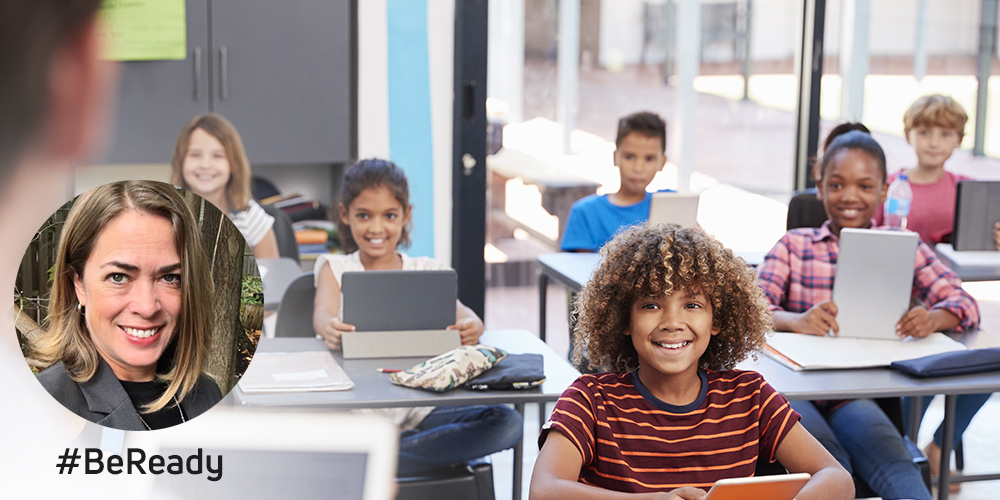Back-to-school reading tips from a Speech-Language Pathologist/Assistive Technology Specialist
Grace is a sixth grade student with a visual impairment who needs enlarged text to read. Bryce, an eighth grader with dyslexia, has difficulty with decoding and fluency and reads below grade level. Brady is in seventh grade and really struggles academically and lacks confidence. These students, and many like them, are unable to read independently because of disabilities.
That’s where Amy Ratajczak comes in. She is a Speech-Language Pathologist and Assistive Technology (AT) Specialist in Erie County, New York. Amy serves students in grades 2-12 with disabilities that affect reading and writing. She and the educational support team – special education teachers, general education teachers, occupational and physical therapists, counselors, psychologists, and paraprofessionals – at Clarence Central School District strive to keep students with learning differences in the least restrictive environment and provide full access to general education with as much support as they need.
Amy recently shared her expert insights. Her answers have been edited for length and clarity.
What are some reading challenges that students encounter?
The pattern of reading disability that I’ve seen is a lack of learning how to decode early in their education. The inability to decode causes a reduction in fluency, which makes it very challenging for students to understand what they have read. Decoding challenges make it difficult when students are first “learning to read” and continue to put them behind the eight ball at higher grades when they should be “reading to learn.”
How Does AT Close the Gap?
Assistive technology with text-to-speech facilitates decoding by allowing students to listen and see the text for greater comprehension and independence. They can repeat sections as needed, slow down the voices, and manipulate how the text appears. As a certified Irlen Screener, I’ve seen many students that prefer larger text (20 point or more), color backgrounds, or a different type of font, like Dyslexie, in order to see the text. Sometimes manipulating how the text appears is all they need. Others need the text-to-speech feature for full understanding and access to grade-level material.
How Does Bookshare Support Reading Independence?
In grades K-4, there is still a focus on improve students’ reading skills. Leveled reading and specialized reading instruction happen daily. By fifth grade, the expectation is that they will read grade-level texts. How does a student do that if they are several grade levels behind? The answer is Bookshare. My students who use Bookshare can access grade-level text independently. For students who try, love to learn, and want to do their best, Bookshare has made a significant difference in their lives. No more baby books. No more embarrassing leveled readers in middle school. They are reading exactly what everyone else is reading or what they want to read.
Edtech Tools Are Ticket to Students’ Success
Back to Grace, Bryce, and Brady. Grace reads three to four books per week using Bookshare Web Reader and Voice Dream Reader to enlarge the text on a Chromebook and an iPad. Bryce can read and understand grade-level text using Bookshare Web Reader with text-to-speech which has allowed him to complete assignments independently. With help from Bookshare and Voice Dream Reader for reading and Read&Write for writing, Brady’s confidence grew, but his love of reading grew even more. Brady has taken a leadership role and helps other students and teachers in how to use reading tools and AT successfully.
I love it when students say to me: “Mrs. Ratajczak, will you put another book on my reading list? I finished the last book already.” I ask them about the book; would they recommend it, did they like it? Having a conversation about books is so important for students who haven’t enjoyed reading in the past.
Learn how you can #BeReady for back to school with Bookshare.
Amy Ratajczak is a Speech-Language Pathologist and Assistive Technology Specialist in western New York. She is also an outreach coordinator for Bookshare. You can reach her at amyr@benetech.org.


We do not know how to use bookshare?
Hi Kim: How can we help you? What specific questions do you have?
How do these children use bookshare in the classroom? Do they use headsets? My son is opposed to “standing out”. (7th grader) We tried using speech to text AT in 4th and 5th grade and he had to leave his classroom to do it and he didn’t like that. It made him stand out. I’m very worried because I’m pretty sure he’s substituting words because of his inability to decode properly. As text becomes increasingly more difficult, I fear it will have an adverse affect on his grades. He had been tutored for 5 years in OG but we moved and can’t find a local OG tutor. He hasn’t completely learned to advocate for himself yet either. I keep renewing my bookshare membership but in 5 years, have yet to use it.
Diane: Thank you for your question. I forwarded it to Amy, the blog author, and asked her to respond to you directly. Stay tuned! Regards, Laura, Bookshare Communications